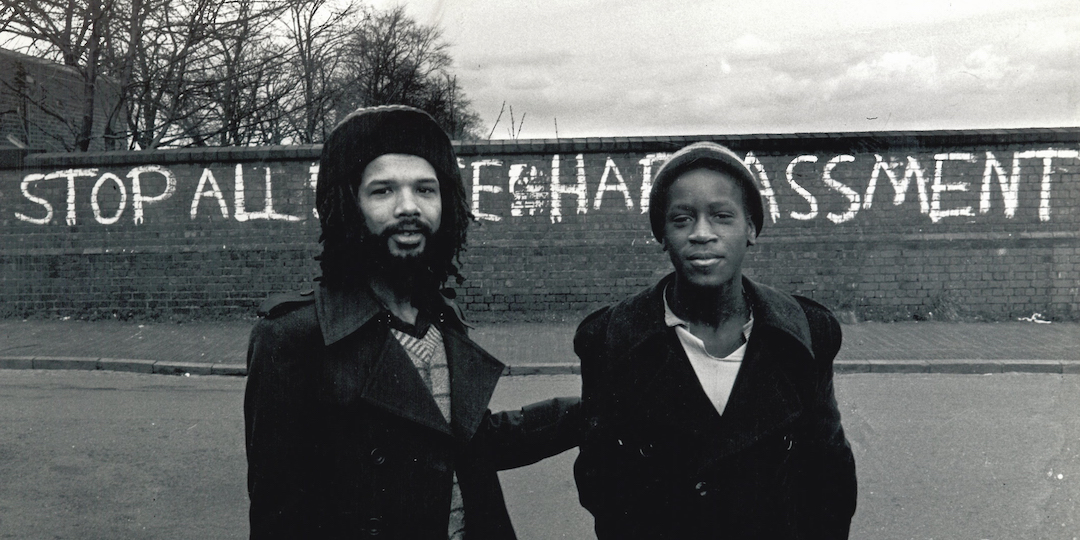Project
Handsworth Alternative Scheme

Two young men on Holly Road, Handsworth 1979.
In June 1979, I applied to become part of a new project called the Handsworth Alternative Scheme (HAS). This was set up for three years with the aid of a Home Office grant to assist the probation service and the Birmingham law courts to provide alternatives to custody for young (17-25) black offenders from the Handsworth area.
Sponsored by Nacro (National Association for the Care and Resettlement of offenders), HAS aimed to provide help in three main areas: education, employment and housing, with social support.
A survey carried out in 1978 by senior probation officer Pat Whitehouse revealed that black offenders were much more likely to be given custodial sentences than their white counterparts. One of the factors contributing to this was that the courts did not remand young blacks for social enquiry reports with the same frequency as they did for their white counterparts.
HAS obtained its own referrals by having a worker located within the courts. This worker would make contact with young black people at court, usually by arriving early in the mornings and checking the daily court lists to identify black clients through their names, or as they were waiting to appear for the first time, and give basic advice on court procedures and the advantages of having a sympathetic solicitor.
HAS was staffed by young black graduates, who like myself, had been drawn into community work because they wanted to make a difference. I was the education officer, and I quickly realised that a significant number of the young people referred to the scheme needed help to improve their reading and writing skills.
When I made arrangements for them to get help in existing adult education institutions they were reluctant to attend because of the lack of appropriate educational resources in these classes, the perceived bias towards white English norms, and the failure of tutors to recognise anything positive in the black experience.
At this time, significant numbers of our client group were hugely influenced by the Rastafarian faith, and they felt, with some justification, that nothing in the existing British education system reflected black people’s culture and interests.
In short, I was working with young black school leavers who had rejected everything to do with ‘Babylon’.
Ferdinand Dennis (who went on to become a very successful writer) was a John F Kennedy Library Foundation research fellow who worked at HAS for nine months. In his report he concluded that:
- Out of a total of 70 clients, more than 60 had left school with no qualifications. The others had some low CSE grades – of dubious worth on the job market.
- Nearly a quarter of our clients had been taken out of ordinary education before the statutory school leaving age. They had attended approved school or ESN.
- Not only had HAS clients left school with no qualifications they also appeared to have left with a determination not to have anything to do with the education system again.
Dennis’ report also revealed, unsurprisingly, that one in four had a reading problem.
The experience I had from working in adult literacy at the Birmingham Settlement had made me aware that although some use was made of Basic Skills classes by older people from the African Caribbean communities (who were less critical of the books and materials in use because they were more keen to grasp the skills of reading) young black people were less attracted to existing classes.
Some education services were provided on the project. These included:
- Adult Literacy classes: I set up and started teaching the classes myself. As numbers grew I recruited and trained volunteers to help.
- Advice on colleges and courses
- Preparation for tests: Clients being offered job training with the Job Preparation Unit in skills such as carpet fitting, and painting and decorating were required to pass a basic literacy and maths test. I arranged for the trainee to get help in preparation for the tests.
- Film Making Course: Run for five weeks by Yugesh Walia of Endboard Films. Participants on the course included a HAS clients, and staff from both HAS and West Midlands Probation Service.
- This allowed staff and clients to work together as a team on an equal basis, developing skills in acting, storyboarding, editing, travelling to different locations to do the shooting, and generally building up invaluable relationships.
- Following on from this course, the film ‘Sweet Chariot’ was made. Sweet Chariot, directed by Yugesh Walia and produced by Handsworth Cultural Centre, looked at white society’s adoption of black culture through dance, music, and fashion. It featured Nancy Johnson (who later headed up Birmingham’s Women’s Unit) and Pat Donaldson (who became a dancer with Kokuma). Some of the participants who attended the Film Making course also appeared in Sweet Chariot.
- Link to BFI webpage with details of sweet chariot
Handsworth Alternative Scheme had a management committee, which included Grace Latibeaudiere-Williams, Richard Sargeant, Jenny Douglas. Derrick Anderson, Valerie Amos, Altehea Edwards, Eddie Gordon, Pat Whitehouse, Mike O’Connor, Andy Housley.
In addition, the project had an Advisory group which included Dr Stuart Hall, Ivan Henry, Bob Ramdhanie, Louis Wright, Dennis Nelson, Bob Nunn, and Iain Crow.